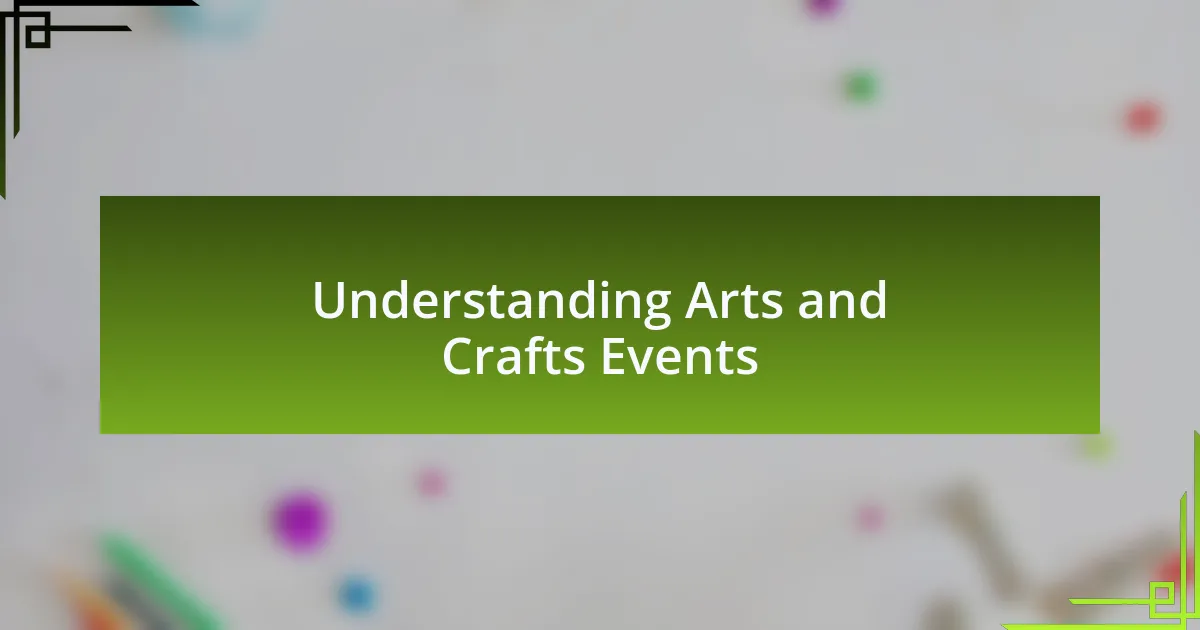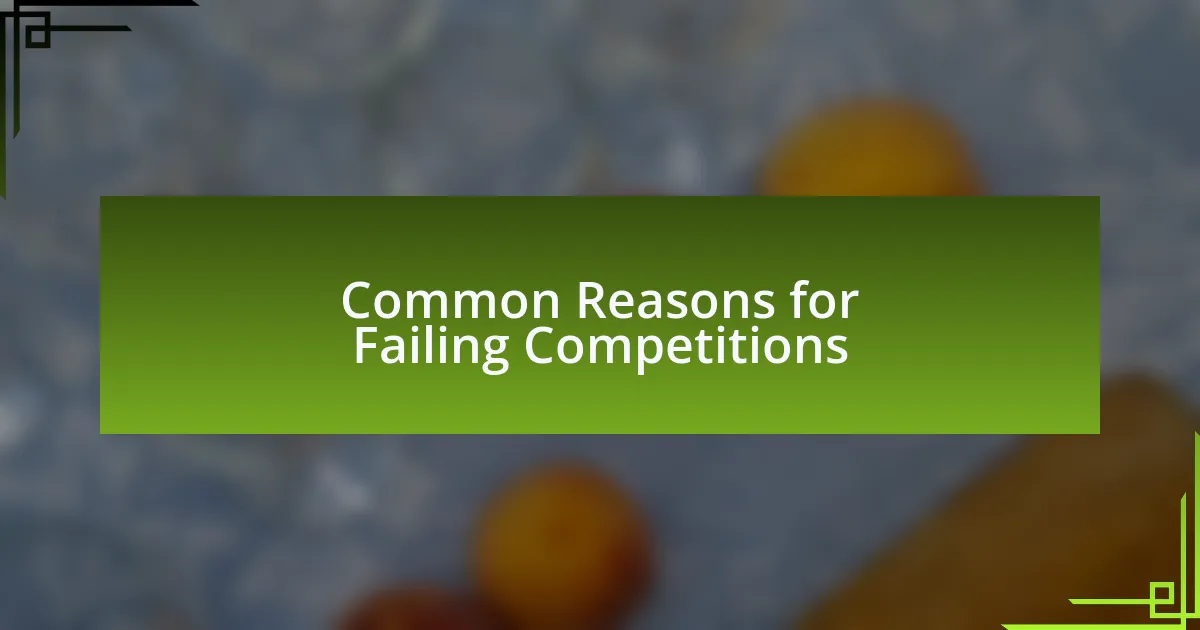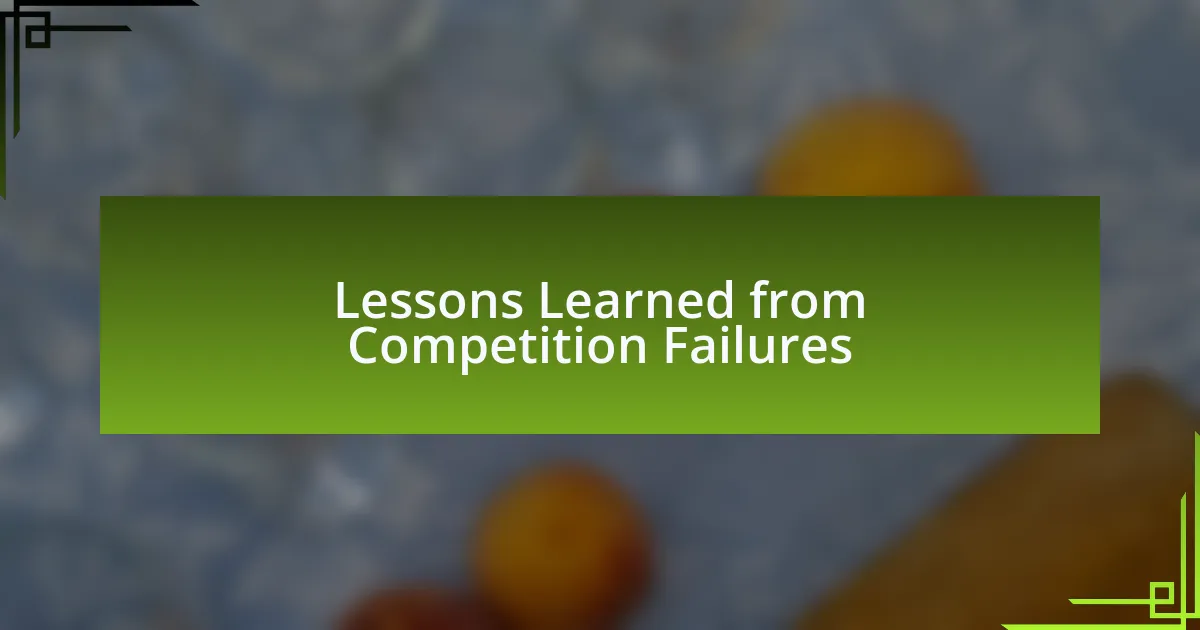Key takeaways:
- Arts and crafts events foster creativity, community, and personal growth through interaction with diverse artisans.
- Competitions enhance artistic development by encouraging experimentation and offering constructive feedback, while also building camaraderie among artists.
- Failures in competitions can teach resilience, the value of constructive criticism, and help artists reconnect with their core motivations.
- Applying lessons from past failures involves experimentation, continuous skill refinement, and setting realistic expectations for future projects.

Understanding Arts and Crafts Events
Arts and crafts events are vibrant gatherings that celebrate creativity, skill, and community. I remember attending a local craft fair where the air was thick with the smell of paint and freshly cut wood. It truly felt like stepping into a world where imagination knew no bounds. Have you ever experienced a moment like that, where the sheer energy of creativity sparks something within you?
These events often showcase a wide variety of artistic expressions, from intricate handmade jewelry to stunning paintings. I was once blown away by how a simple piece of paper could be transformed into a beautiful origami sculpture. It made me wonder: what drives these artisans to share their talent? It’s a mix of passion, dedication, and the desire to connect with others who appreciate their work.
Moreover, participating in these events can be a profound learning experience. Reflecting on my own journey, I’ve met so many talented individuals, each with their unique story. I often think, what can I extract from their experiences that can enhance my own craft? Engaging in conversations at these events can open up new perspectives and inspire growth as both an artist and a community member.

Importance of Competitions in Arts
Competitions play a crucial role in the arts by pushing artists to elevate their craft. I remember entering my first local competition, nervously adjusting the colors on my canvas. Despite the fear of failure, it ignited a spark within me to experiment creatively, leading to breakthroughs in my style that I hadn’t anticipated. Isn’t it fascinating how a little competition can propel us to explore uncharted territories in our art?
The exposure gained from competitions can be transformative. I once showcased my work at an event that not only garnered attention but also provided valuable feedback from judges and peers alike. Hearing their thoughts—both positive and critical—was like opening a window to new ideas. This exchange of perspectives is invaluable, as it fosters growth, and makes us more resilient artists.
Beyond personal growth, competitions cultivate a sense of community among artists. I still recall the camaraderie at a regional arts competition where we supported each other, sharing tips while prepping our booths. It’s moments like these that truly highlight the essence of art: collaboration and connection. Have you ever felt that unforgettable bond with fellow creators during such an event? It’s these experiences that make competitions worthwhile, enriching both our skills and our relationships within the arts community.

Common Reasons for Failing Competitions
Many artists stumble in competitions due to a lack of clarity in their vision. I remember a time when I poured my heart into a piece, but it didn’t convey what I intended. The judges’ feedback was clear: the message was lost amidst technical details. How often do we get so caught up in perfection that we forget to tell our story?
Another common pitfall is not understanding the competition’s criteria. I once submitted an artwork that I adored, only to realize later that it didn’t align with the theme. That experience taught me the importance of carefully reviewing guidelines—it’s like missing a crucial step in a recipe. Have you ever poured effort into something, only to find it wasn’t what the jury was looking for?
Sometimes, overthinking can lead to paralysis in creative expression. I’ve been there, meticulously adjusting every detail until I lost sight of the initial spark that inspired me. It’s important to remember that art is about feeling as much as it is about technique. Isn’t it intriguing how a moment of hesitation can derail the entire process?

Lessons Learned from Competition Failures
When reflecting on competition failures, one crucial lesson I learned is the power of resilience. I vividly remember my first competition, where I felt utterly devastated after not placing. Yet, that experience pushed me to reassess my approach and explore new styles. Have you ever had a setback that ultimately fueled your growth?
Another important takeaway is the value of constructive criticism. After failing to impress the judges, I sought feedback and was surprised by the insightful perspectives they offered. It dawned on me that understanding others’ viewpoints can sharpen our artistic vision. How often do we view criticism as a personal attack instead of a stepping stone?
Lastly, embracing vulnerability has been transformative in my artistic journey. I recall a moment of sharing my work with a close friend before a big competition. Their genuine reaction reminded me that art isn’t just about accolades; it’s about connection. In moments of failure, we often rediscover our passion and the deeper reasons we create. Have you tapped into that emotional core behind your art?

Applying Failures to Future Projects
When I think about applying failures to future projects, I find that experimentation becomes a guiding principle. After a particularly disappointing experience with a mixed media piece, I vowed to try something radically different. Diving into watercolor unexpectedly unlocked a new layer of creativity I hadn’t tapped into before. Have you ever found that stepping outside your comfort zone led you to unexpected artistic breakthroughs?
One impactful lesson I’ve gathered is the importance of refining my skills through practice. After my last event, I set specific goals to improve my technique. I enrolled in workshops where I could focus on areas that needed strengthening, like color theory and composition. How often do we underestimate the value of continuous learning in our craft?
Lastly, I realized the significance of setting realistic expectations. A few years back, eager to impress, I poured my heart into a complex sculpture. While I didn’t earn the recognition I hoped for, that project taught me to align my ambitions with my current abilities. Reflecting on that, I often ponder whether it’s the journey that defines our work rather than the accolades. How do you measure success in your artistic endeavors?